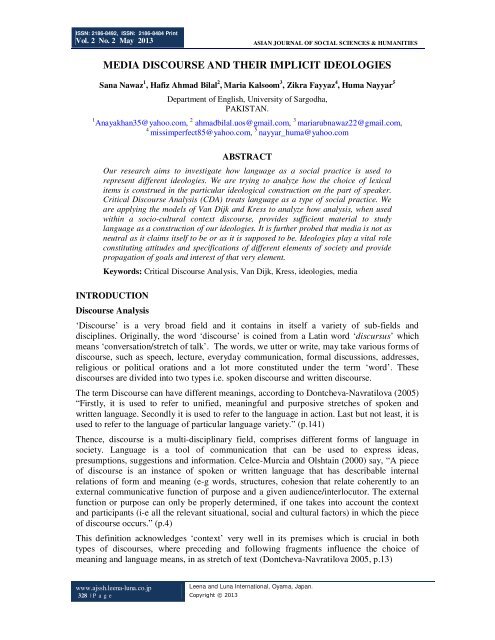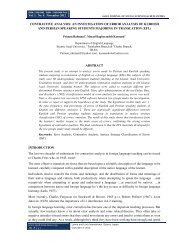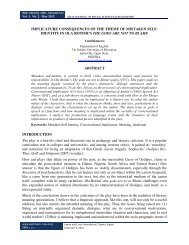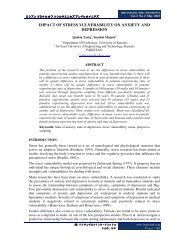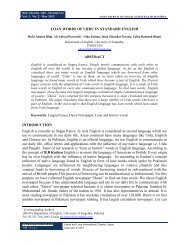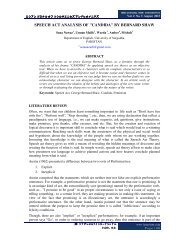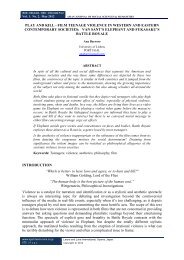Full Paper - Asian Journal of Social Sciences and Humanities (AJSSH)
Full Paper - Asian Journal of Social Sciences and Humanities (AJSSH)
Full Paper - Asian Journal of Social Sciences and Humanities (AJSSH)
You also want an ePaper? Increase the reach of your titles
YUMPU automatically turns print PDFs into web optimized ePapers that Google loves.
ISSN: 2186-8492, ISSN: 2186-8484 Print<br />
Vol. 2 No. 2 May 2013<br />
ASIAN JOURNAL OF SOCIAL SCIENCES & HUMANITIES<br />
MEDIA DISCOURSE AND THEIR IMPLICIT IDEOLOGIES<br />
Sana Nawaz 1 , Hafiz Ahmad Bilal 2 , Maria Kalsoom 3 , Zikra Fayyaz 4 , Huma Nayyar 5<br />
Department <strong>of</strong> English, University <strong>of</strong> Sargodha,<br />
PAKISTAN.<br />
1 Anayakhan35@yahoo.com, 2 ahmadbilal.uos@gmail.com, 3 mariarubnawaz22@gmail.com,<br />
4<br />
missimperfect85@yahoo.com, 5 nayyar_huma@yahoo.com<br />
ABSTRACT<br />
Our research aims to investigate how language as a social practice is used to<br />
represent different ideologies. We are trying to analyze how the choice <strong>of</strong> lexical<br />
items is construed in the particular ideological construction on the part <strong>of</strong> speaker.<br />
Critical Discourse Analysis (CDA) treats language as a type <strong>of</strong> social practice. We<br />
are applying the models <strong>of</strong> Van Dijk <strong>and</strong> Kress to analyze how analysis, when used<br />
within a socio-cultural context discourse, provides sufficient material to study<br />
language as a construction <strong>of</strong> our ideologies. It is further probed that media is not as<br />
neutral as it claims itself to be or as it is supposed to be. Ideologies play a vital role<br />
constituting attitudes <strong>and</strong> specifications <strong>of</strong> different elements <strong>of</strong> society <strong>and</strong> provide<br />
propagation <strong>of</strong> goals <strong>and</strong> interest <strong>of</strong> that very element.<br />
Keywords: Critical Discourse Analysis, Van Dijk, Kress, ideologies, media<br />
INTRODUCTION<br />
Discourse Analysis<br />
‘Discourse’ is a very broad field <strong>and</strong> it contains in itself a variety <strong>of</strong> sub-fields <strong>and</strong><br />
disciplines. Originally, the word ‘discourse’ is coined from a Latin word ‘discursus’ which<br />
means ‘conversation/stretch <strong>of</strong> talk’. The words, we utter or write, may take various forms <strong>of</strong><br />
discourse, such as speech, lecture, everyday communication, formal discussions, addresses,<br />
religious or political orations <strong>and</strong> a lot more constituted under the term ‘word’. These<br />
discourses are divided into two types i.e. spoken discourse <strong>and</strong> written discourse.<br />
The term Discourse can have different meanings, according to Dontcheva-Navratilova (2005)<br />
“Firstly, it is used to refer to unified, meaningful <strong>and</strong> purposive stretches <strong>of</strong> spoken <strong>and</strong><br />
written language. Secondly it is used to refer to the language in action. Last but not least, it is<br />
used to refer to the language <strong>of</strong> particular language variety.” (p.141)<br />
Thence, discourse is a multi-disciplinary field, comprises different forms <strong>of</strong> language in<br />
society. Language is a tool <strong>of</strong> communication that can be used to express ideas,<br />
presumptions, suggestions <strong>and</strong> information. Celce-Murcia <strong>and</strong> Olshtain (2000) say, “A piece<br />
<strong>of</strong> discourse is an instance <strong>of</strong> spoken or written language that has describable internal<br />
relations <strong>of</strong> form <strong>and</strong> meaning (e-g words, structures, cohesion that relate coherently to an<br />
external communicative function <strong>of</strong> purpose <strong>and</strong> a given audience/interlocutor. The external<br />
function or purpose can only be properly determined, if one takes into account the context<br />
<strong>and</strong> participants (i-e all the relevant situational, social <strong>and</strong> cultural factors) in which the piece<br />
<strong>of</strong> discourse occurs.” (p.4)<br />
This definition acknowledges ‘context’ very well in its premises which is crucial in both<br />
types <strong>of</strong> discourses, where preceding <strong>and</strong> following fragments influence the choice <strong>of</strong><br />
meaning <strong>and</strong> language means, in as stretch <strong>of</strong> text (Dontcheva-Navratilova 2005, p.13)<br />
www.ajssh.leena-luna.co.jp<br />
328 | P a g e<br />
Leena <strong>and</strong> Luna International, Oyama, Japan.<br />
Copyright © 2013
エシアン ゾロナル オフ ソシルサエニセズ アンドヒオメニテズ<br />
ISSN: 2186-8492, ISSN: 2186-8484 Print<br />
Vol. 2 No. 2 May 2013<br />
In 1996, a spokesperson for British Telecom (BT) launched a campaign to improve the<br />
nation’s communication skills, explaining that ‘since life is in many ways a series <strong>of</strong><br />
communication, it makes sense to be as good as we possibly can be, at something we tend to<br />
take for granted’ (quoted in Guardian, 30 December 1996, as cited in Cameron, 2001).<br />
The spoken discourse analysts do not usually work upon the above-described principles.<br />
They do not work for making people better in communication or skilled in interaction. Rather<br />
they begin from the assumption that people are highly skilled users <strong>of</strong> language in their dayto-day<br />
interaction. Language, they suppose is a skill at which people are already best<br />
equipped.<br />
Our life is a series <strong>of</strong> conversations. Our everyday social life is almost completely delineated<br />
by language. Language is definitely a social phenomena <strong>and</strong> it lives <strong>and</strong> flourishes because <strong>of</strong><br />
its roles to perform in society. However, it makes an interesting account to notice that surface<br />
meanings are always or almost always different from the real meanings <strong>and</strong> the aim <strong>of</strong><br />
discourse analysis is to bring forth how speech patterns are working in a particular<br />
framework. “Using a language invokes something that goes beyond the acquisition<br />
<strong>of</strong>structures <strong>and</strong> ability to make appropriate choices in the realizations <strong>of</strong> particular language<br />
function.” (Yalden, 1987, p.39)<br />
Then again, there lies a difference between the approaches <strong>of</strong> discourse analysts. As some are<br />
concerned strictly with the complex structures <strong>and</strong> social mechanism <strong>of</strong> language, being used<br />
by people, they are more concerned with the rules <strong>of</strong> turn-taking, strategies <strong>of</strong> effective<br />
communication <strong>and</strong> with the problems like misunderst<strong>and</strong>ings <strong>and</strong> confusions that arise out<br />
<strong>of</strong> miscommunication. On the other h<strong>and</strong>, there are analysts that are broadly concerned with<br />
the view that life is a series <strong>of</strong> communication <strong>and</strong> they analyze people’s talk as an evidence<br />
<strong>of</strong> their aspects <strong>of</strong> life, their beliefs, notions <strong>and</strong> prejudices.<br />
Discourse is characteristic <strong>of</strong> the way <strong>of</strong> thinking on the state <strong>of</strong> knowledge that appears<br />
through the speech <strong>of</strong> a person at various stages in society. Foucault (1969) imagines<br />
discourse as “the totality <strong>of</strong> all the effective sentences (whether spoken or written) in their<br />
dispersion as events” (p.27). Discourse refers to ‘very specific patterns <strong>of</strong> language that tell<br />
us something about the person speaking the language, the culture that person is part <strong>of</strong>, the<br />
network <strong>of</strong> social institutions that the person is caught up in <strong>and</strong> even the most basic<br />
assumptions that the person holds’ (Whisnant, 2012, pp. 4-5)<br />
Such an analysis <strong>of</strong> language is called discourse analysis <strong>and</strong> it is very helpful in portraying<br />
what talking accomplishes in people’s lives <strong>and</strong> society. In this paper, we have tried to check<br />
the usage <strong>of</strong> language on the basis <strong>of</strong> its social <strong>and</strong> contextual impact <strong>and</strong> to check how much<br />
the language <strong>of</strong> electronic media is laden with social prejudices <strong>and</strong> ideals.<br />
Critical Discourse Analysis<br />
CDA is defined by Fairclough (1992) as ‘discourse analysis which aims to systematically<br />
explore <strong>of</strong>ten opaque relationships <strong>of</strong> causality <strong>and</strong> determination between (a) discursive<br />
practices, events <strong>and</strong> texts, <strong>and</strong> (b) wider social <strong>and</strong> cultural structures, relations <strong>and</strong><br />
processes; to investigate how such practices, events <strong>and</strong> texts arise out <strong>of</strong> <strong>and</strong> are<br />
ideologically shaped by relations <strong>of</strong> power <strong>and</strong> struggles over power; <strong>and</strong> to explore how the<br />
opacity <strong>of</strong> these relationships between discourse <strong>and</strong> society is itself a factor securing power<br />
<strong>and</strong> hegemony’. (p.135)<br />
According to kress (1990, as cited in Dellinger, 1995), “CDA refers language a social process<br />
among people used for representation <strong>and</strong> communication including visual images, music,<br />
gestures etc. Texts are produced by socially situated speakers <strong>and</strong> writers.Participants in<br />
( 株 ) リ リ<br />
アンドル リ ル ル ル ル リ ル ル リ ル<br />
小 山 市 、 日 本 .<br />
www. leena-luna.co.jp<br />
P a g e | 329
ISSN: 2186-8492, ISSN: 2186-8484 Print<br />
Vol. 2 No. 2 May 2013<br />
ASIAN JOURNAL OF SOCIAL SCIENCES & HUMANITIES<br />
conversation or in producing texts has no equal participation every time; there will be a range<br />
from complete solidarity to complete inequality. Speakers <strong>and</strong> listeners sort out meanings<br />
during their interaction <strong>and</strong> with the help <strong>of</strong> context <strong>and</strong> linguistic features form because <strong>of</strong><br />
social processes, which are never arbitrary. Speakers use linguistic features most specifically<br />
according to their social positions.History may also be taken into account, as ideologically<br />
<strong>and</strong> politically “inflected time”. Finally, precise analysis <strong>and</strong> "descriptions <strong>of</strong> the materiality<br />
<strong>of</strong> language" are factors which are always characteristic <strong>of</strong> CDA.” According to him accurate<br />
analysis, descriptions about usage <strong>of</strong> linguistic features <strong>and</strong> about their materiality are factors,<br />
which are always characteristic <strong>of</strong> CDA. Beside language structure, ideology has its own<br />
importance in CDA. Kress emphasizes that any linguistic form has no meaning in isolation,<br />
nor does it possess any ideological signification or function.<br />
According to Van Dijk (1995), “ideologies are typically, though not exclusively, expressed<br />
<strong>and</strong> reproduced in discourse <strong>and</strong> communication, including non-verbal semiotic messages,<br />
such as pictures, photographs <strong>and</strong> movies" (p.17).<br />
We have used the model <strong>of</strong> Van Dijk (1995) (the main tenets are described below) to unravel<br />
the hidden ideologies <strong>of</strong> different newspaper headlines:<br />
a. Examining the context <strong>of</strong> the discourse: historical, political or social background <strong>of</strong><br />
a conflict <strong>and</strong> its conflicts.<br />
b. To analyze groups, power relations <strong>and</strong> conflicts.<br />
c. Identifying positive <strong>and</strong> negative opinions about Us versus Them.<br />
d. Making explicit the presupposed <strong>and</strong> the implied.<br />
e. Examining all formal structures: lexical choices <strong>and</strong> syntactic structure, in a way<br />
that helps to (de)emphasize polarized group opinions.<br />
Here we followed the above process firstly giving the background <strong>of</strong> the newspaper whose<br />
ideologies are under investigation, <strong>and</strong> then we looked for contradictions <strong>of</strong> their opinions by<br />
checking their “Us” versus “Them” opinions <strong>and</strong> finally their formal structure, lexical or<br />
main participants.<br />
Media Studies<br />
“Media Studies” the entry begins “is the study <strong>of</strong> the constitution, history, <strong>and</strong> effects <strong>of</strong><br />
media.” (Mitchell, 2010, p.1). It goes on to divide media studies (usefully, to be sure) into<br />
two traditions: on the one h<strong>and</strong>, “the tradition <strong>of</strong> empirical sciences like communication<br />
studies, sociology <strong>and</strong> economics,” which “generally focus on Mass Media, their political,<br />
social, economic <strong>and</strong> cultural role <strong>and</strong> impact in creating <strong>and</strong> distributing content to media<br />
audiences”; on the other h<strong>and</strong>, “the tradition <strong>of</strong> humanities like literary theory, film/video<br />
studies, cultural studies <strong>and</strong> philosophy,” which “focus on the constitution <strong>of</strong> media <strong>and</strong><br />
question … (how) they shape what is regarded as knowledge <strong>and</strong> as communicable.” Media<br />
studies thus comprises any study <strong>of</strong> media, within any discipline or interdiscipline, <strong>and</strong> may<br />
be subdivided according to the conventions governing research in those fields (Mitchell,<br />
2010, p.1)<br />
For taking the idea <strong>of</strong> media, we have to underst<strong>and</strong> that it is like a light bulb that is<br />
illuminating the surrounding by showing the real hidden places. With the perspective <strong>of</strong><br />
media, we are going to underst<strong>and</strong> what is actually going in the situation.<br />
It is important to inform that media is telling its own perspective. The thing really is<br />
something different from the explanation <strong>of</strong> media. Actually, media tries to communicate in a<br />
subjective manner rather than objective one. The words spoken or written by media seem to<br />
www.ajssh.leena-luna.co.jp<br />
330 | P a g e<br />
Leena <strong>and</strong> Luna International, Oyama, Japan.<br />
Copyright © 2013
エシアン ゾロナル オフ ソシルサエニセズ アンドヒオメニテズ<br />
ISSN: 2186-8492, ISSN: 2186-8484 Print<br />
Vol. 2 No. 2 May 2013<br />
be objective but actually, they are subjective <strong>and</strong> implicitly laden with the ideologies <strong>of</strong><br />
media. “The world <strong>of</strong> the Press is not the real world rather a partial one which is skewed <strong>and</strong><br />
judged” (Fowler, 1991, p.11).<br />
Moreover, we mostly witness this type <strong>of</strong> implicit subjectivity in print <strong>and</strong> electronic media<br />
both. Media is a broad field dealing with communication by the help <strong>of</strong> different mediums<br />
like TV, radio or newspaper. Every channel, every newspaper is somewhat partial <strong>and</strong> they<br />
do keep their ideologies <strong>and</strong> perspectives in their minds when portraying any issue. This<br />
communication is a sort <strong>of</strong> direct interaction with the viewers <strong>and</strong> in case <strong>of</strong> newspapers, the<br />
readers. This communication is the biggest source <strong>of</strong> our experience <strong>of</strong> the world especially<br />
the political world. Our leaders propagate their ideologies through their manipulated<br />
language. Because <strong>of</strong> this manipulation, language is becoming more formal <strong>and</strong> advanced.<br />
So are becoming media studies more intriguing.<br />
The objective <strong>of</strong> media studies is to analyze, judge <strong>and</strong> evaluate media that provides guidance<br />
to people, who want to make their expression more pr<strong>of</strong>essional <strong>and</strong> more composed. It gives<br />
them opportunity to avoid the charges <strong>of</strong> biasness.<br />
Key aspects <strong>of</strong> Media Studies<br />
Firstly, the main thing to notice is the medium through which information is delivered.<br />
Secondly the language, which is used in it should be technical <strong>and</strong> in the form <strong>of</strong> address so<br />
that it may highlight the aim <strong>of</strong> media as the code <strong>of</strong> addressing. Thirdly, language should be<br />
in the form <strong>of</strong> narrative composition.<br />
Media deals on individual, national <strong>and</strong> global levels. It shows that media is conveying to<br />
people the views <strong>of</strong> one person; while on the other h<strong>and</strong>, it tells them about particular nation<br />
or the world views overall. Media deals with individuals <strong>and</strong> groups in some particular<br />
context, the social, cultural <strong>and</strong> political events.<br />
It is the clear indication <strong>of</strong> ‘how a man deals with the particular situations’. Ideologies, which<br />
are presented by media, portray sometimes objectivity, impartiality <strong>and</strong> sometimes<br />
subjectivity. Media has now become an integral part <strong>of</strong> society <strong>and</strong> is contributing its part<br />
efficiently in the present global village. Media as a picture <strong>of</strong> society shows how the world is<br />
going on, what is the condition people facing <strong>and</strong> how positive changes can be brought about<br />
in the present social circle.<br />
BACKGROUND OF THE STUDY<br />
Currently, we see a lot <strong>of</strong> disturbance on the political scenario <strong>of</strong> Pakistan. Pakistan has<br />
already been exposed to the severe problems <strong>of</strong> inflation, energy crisis <strong>and</strong> the severe<br />
conflicts between government <strong>and</strong> judiciary. Most recently, the issue <strong>of</strong> ‘long march’ has<br />
been given much space in print <strong>and</strong> electronic media.<br />
In the current paper, we are trying to access this phenomenon from the perspective <strong>of</strong> print<br />
media <strong>and</strong> are looking at how seemingly implicit <strong>and</strong> objective statements <strong>of</strong> newspapers are<br />
loaded with their subjective ideologies. For this purpose, we have taken the headlines <strong>of</strong> 5<br />
popular newspapers <strong>of</strong> 18 th January <strong>and</strong> have tried to check how media is highlighting this<br />
issue <strong>of</strong> ‘long march’ in its stereotypical way.<br />
On 14 th January, the followers <strong>of</strong> Dr Tahirul Qadri - a Canadian nationality holder who<br />
arrived in Pakistan during the last month (December 2012) demonstrated a march from<br />
Lahore to Islamabad with the slogan to bring about a change in the politics <strong>of</strong> Pakistan. They<br />
raised the slogans <strong>of</strong> revolution. Nevertheless, on the other side, some analysts view this<br />
process as a conspiracy against Pakistani politics <strong>and</strong> democratic process.<br />
( 株 ) リ リ<br />
アンドル リ ル ル ル ル リ ル ル リ ル<br />
小 山 市 、 日 本 .<br />
www. leena-luna.co.jp<br />
P a g e | 331
ISSN: 2186-8492, ISSN: 2186-8484 Print<br />
Vol. 2 No. 2 May 2013<br />
ASIAN JOURNAL OF SOCIAL SCIENCES & HUMANITIES<br />
TahirulQadri is engaged feverishly in his campaign for ‘electoral reforms’. His dem<strong>and</strong>s have<br />
included getting the upcoming general elections <strong>of</strong> the country postponed. He has also made<br />
a call on dissolving the assemblies <strong>and</strong> for the formation <strong>of</strong> neutral caretaker government.<br />
Introduction to the Newspapers<br />
In this section, we have tried to probe into the different agendas <strong>of</strong> different newspapers (Jan<br />
18, 2013) by comparing their headlines on the same issue <strong>and</strong> analysing how they represent<br />
their ideologies coloured with lexical <strong>and</strong> syntactical choices <strong>and</strong> try to manipulate the<br />
public’s opinion.<br />
ANALYSIS<br />
Headlines <strong>of</strong> the daily Express on January 18, 2013.<br />
Translation: ‘No dissolution <strong>of</strong> either assemblies or the election commission, rather it ended the<br />
protest’<br />
The main heading focuses on the basic aim <strong>of</strong> Tahirul Qadri that shows the stronger part <strong>of</strong><br />
government heavy on the intentions <strong>of</strong> Sheikh ul Islam. Whether he is a religious scholar <strong>and</strong><br />
put much emphasis on the public <strong>and</strong> government through religious declarations <strong>and</strong> different<br />
references .This newspaper focuses on this proverb ‘’all is well that ends well’’.<br />
Throughout the speeches <strong>of</strong> Mr Qadri, we come to know that he is focusing on the needs <strong>of</strong><br />
Pakistanis by showing that poor people are totally facing the problems like poverty, shortage<br />
<strong>of</strong> water supply <strong>and</strong> some other basic needs. He declares on 15 January that Election<br />
Commission has not much power to select ideal sort <strong>of</strong> people for public. Rules <strong>and</strong><br />
regulations are not observed by the people, due to which these assemblies have performed<br />
very badly, so there are many problems.<br />
The headline shows how successful is the march in achieving its aims. Allama has millions <strong>of</strong><br />
people with him, even in such a bad weather with clouds raining for 3 to 4 days, but<br />
unfortunately, he gets nothing, as his main motives were not even considered by the<br />
government. Again, another media channel shows how Mr Qadri did a conversation with the<br />
army <strong>of</strong> YAZEED (a metaphor <strong>of</strong> brutality in the Islamic history) <strong>and</strong> how HUSSAINI army<br />
could even had a conversation with YAZEED.<br />
Mr Qadri said that ‘in the name <strong>of</strong> democracy again <strong>and</strong> again same corrupt people came into<br />
power, who are just looting the country <strong>and</strong> the parliament is captured by such people whose<br />
focus is to fulfil their nefarious ends instead <strong>of</strong> serving people (speech in Islamabad delivered<br />
on 15 January)<br />
www.ajssh.leena-luna.co.jp<br />
332 | P a g e<br />
Leena <strong>and</strong> Luna International, Oyama, Japan.<br />
Copyright © 2013
エシアン ゾロナル オフ ソシルサエニセズ アンドヒオメニテズ<br />
ISSN: 2186-8492, ISSN: 2186-8484 Print<br />
Vol. 2 No. 2 May 2013<br />
Media is portraying a prejudiced picture <strong>of</strong> Tahir ul Qadri by ridiculing him <strong>and</strong> belittling<br />
him, who has emerged as an exponent <strong>of</strong> anti status quo. What he says is the voice <strong>of</strong> millions<br />
<strong>of</strong> people, as he has taken a step for the betterment <strong>of</strong> the society <strong>of</strong> Pakistan. What he said is<br />
real <strong>and</strong> is the prevailing scenario in Pakistan that can be proved as one looks at the<br />
surroundings <strong>of</strong> Pakistan. Media actually gives its own theory implicitly under the guise <strong>of</strong><br />
supporting democracy. Therefore, it is proved whatever the circumstances are, media has its<br />
own trumpet to blow.<br />
Here it is observed that ‘the daily’ portrays the outcome <strong>of</strong> ‘the March’ in a way as to<br />
influence the opinion <strong>of</strong> the readers <strong>and</strong> to discourage them to participate in any such activity<br />
in future, which may be taken as a conscious effort to support the forces <strong>of</strong> status quo.<br />
The daily Jang narrates the same story as:<br />
Translation: “Assembly dissolve before March 16, Elections in 90 days. A written pact between<br />
government <strong>and</strong> Tahirul Qadri”<br />
This headline <strong>of</strong> the daily narrates the same story in somewhat different way coloured with<br />
lexical items <strong>of</strong> their own choice which represents their ‘ideology’ about the issue, their<br />
prejudices, their propag<strong>and</strong>a if any, their viewpoint about the agreement, etc.<br />
This statement, specifically “written pact” <strong>and</strong> “dharna ended”, shows that they are<br />
considering long march as revolutionary step which compels the government to hold a<br />
dialogue <strong>and</strong> to make an agreement with Tahirul Qadri. The critical examination <strong>of</strong> “Dharna<br />
ended” highlights as if they are presenting ‘long march’ a right step <strong>and</strong> when its dem<strong>and</strong>s<br />
were fulfilled, it created no more disturbance <strong>and</strong> dispersed peacefully. The idea is<br />
strengthened because at the same paper writes that Tahirul Qadri succeeded in bringing a<br />
great change in Pakistani politics.<br />
The news item, along with the headline, shows a s<strong>of</strong>t corner for the Long March. Because the<br />
government delegation with whom Qadri resolved the issue through dialogue <strong>and</strong> by making<br />
agreement consisted <strong>of</strong> the same people who were criticizing Qadri a day before that he was<br />
hatching conspiracy against the democratic system <strong>and</strong> was considering him the agent <strong>of</strong> the<br />
forces working against democracy; but the words “written pact” appears ironic towards such<br />
people.<br />
Now let us turn our attention to a daily that is famous for its thrilling presentation <strong>of</strong> news,<br />
i.e. the daily Khabrain. The headline goes<br />
( 株 ) リ リ<br />
アンドル リ ル ル ル ル リ ル ル リ ル<br />
小 山 市 、 日 本 .<br />
www. leena-luna.co.jp<br />
P a g e | 333
ISSN: 2186-8492, ISSN: 2186-8484 Print<br />
Vol. 2 No. 2 May 2013<br />
ASIAN JOURNAL OF SOCIAL SCIENCES & HUMANITIES<br />
“Negran wazeer e azam Qadri kay mushwray say bnega” (Urdu)<br />
Translation: “Caretaker prime minister will be appointed after due consultation with Qadri”<br />
This statement <strong>of</strong> the daily Kahbrain presents one <strong>of</strong> the tenets <strong>of</strong> the agreement signed<br />
between Qadri <strong>and</strong> the government. The headline contains the word ‘consultation’ that seems<br />
to be a taunt on Qadri’s dem<strong>and</strong> that new caretaker prime minister should be according to his<br />
wishes <strong>and</strong> the purpose <strong>of</strong> the Long March was only to ensure Qadri’s share in the caretaker<br />
set up.<br />
This dem<strong>and</strong> apparently is unlawful because according to the constitution, caretaker prime<br />
minister would always be appointed through a settlement between the government <strong>and</strong> the<br />
opposition, <strong>and</strong> Tahir ul Qadri does not fit in the puzzle.<br />
The night <strong>of</strong> 17 th January brought a great blessing for the participants <strong>of</strong> Long March, who<br />
were striving in that cold night <strong>of</strong> Islamabad. They were preparing themselves to listen to the<br />
outcome <strong>of</strong> their long struggle <strong>and</strong> luckily, the result brought happiness for them, at least<br />
apparently. The next day every newspaper highlighted the same issue <strong>and</strong> the paper under<br />
study (i.e. the daily Nawa-e-Waqt) also broke the same story headlines as all the morning<br />
issues <strong>of</strong> newspaper.as it is already established it is the publication <strong>of</strong> 18th January. It states<br />
the matter as:<br />
Translation: “Talk between Government <strong>and</strong> Tahirul Qadri succeeded. Dharna ended. The protestors<br />
returned home celebrating”<br />
Apparently, it seems very natural that it suggests the impartiality <strong>of</strong> the newspaper, it has<br />
portrayed directly the matter without any prejudice but analyze the words <strong>of</strong> the writer given<br />
below which are part <strong>of</strong> this headline:<br />
www.ajssh.leena-luna.co.jp<br />
334 | P a g e<br />
Leena <strong>and</strong> Luna International, Oyama, Japan.<br />
Copyright © 2013
エシアン ゾロナル オフ ソシルサエニセズ アンドヒオメニテズ<br />
ISSN: 2186-8492, ISSN: 2186-8484 Print<br />
Vol. 2 No. 2 May 2013<br />
“Shurka jashan manaate gharoon ko wapis”<br />
“the participants went home , celebrating”<br />
It straightforwardly indicates what TahirulQadri was propagating that the march was for the<br />
betterment <strong>of</strong> the whole Nation. It indicates that the writer is <strong>of</strong> the view that it is the<br />
agreement <strong>of</strong> a few people not <strong>of</strong> the nation. Remaining very alo<strong>of</strong> <strong>and</strong> implicit, the journalist<br />
criticizes the actual motives <strong>of</strong> this agreement <strong>and</strong> is also indicating that the case is not as<br />
simple as is being portrayed by MQI (Minhajul Quran International) <strong>and</strong> again those few<br />
people are celebrating their success. The writer has not implied that the whole <strong>of</strong> the nation is<br />
rejoicing (which is actually wrong). So by implying such words he is suggesting clearly his<br />
motif. Moreover, the thing to notice here is that he has not said that the conference was<br />
success rather he has played with the words by suggesting that it is a success for Government,<br />
TairulQadri <strong>and</strong> for the participants.<br />
Additionally if we observe the remaining part <strong>of</strong> this news, it runs<br />
“DrTahirulQadri ne Jumerat ko shaded barish me apne khitaab ke doran Dharney mein<br />
shareek afraad khas tor par khawateen or bachoon ke liey Hakoomat ki taraf sey koi<br />
intazamaat na karney par hukmaranon ko ‘be-haya’ Ka khitaab de diya” (Urdu)<br />
Translation: “Tahirul Qadri titled the government as shameless during his speech on<br />
Thursday in heavy rain for the unavailability <strong>of</strong> special arrangements for children <strong>and</strong><br />
women.”<br />
Again, it would be a very interesting to look at the title <strong>of</strong> this remaining part as “titles” by<br />
the editor. What makes it interesting <strong>and</strong> intriguing is that the writer instead <strong>of</strong> stating the<br />
details <strong>of</strong> this agreement is likely to account for the abusive language Tahirul Qadri used for<br />
the government before this agreement, <strong>and</strong> is somehow criticizing both the parties for the<br />
hollowness <strong>of</strong> this signed pact. The point to notice here is that, the journalist seems very<br />
impartial apparently but by implicit ways he is guiding his readers to reveal the half-hidden<br />
Truth <strong>of</strong> the matter; which according to him is a complete Truth.<br />
Headline in the daily Pakistan runs:<br />
Hakoomat ney Tahir ul Qadri key mutaalibat Tasleem karliey”<br />
Translation: “Government has accepted the dem<strong>and</strong>s <strong>of</strong> TahirulQadri”<br />
This statement is beautiful depiction <strong>of</strong> media’s play upon words. It indicates that media<br />
whether it be electronic or print, plays with the words to present the direct or slight opposite<br />
<strong>of</strong> what has been apparently stated.<br />
( 株 ) リ リ<br />
アンドル リ ル ル ル ル リ ル ル リ ル<br />
小 山 市 、 日 本 .<br />
www. leena-luna.co.jp<br />
P a g e | 335
ISSN: 2186-8492, ISSN: 2186-8484 Print<br />
Vol. 2 No. 2 May 2013<br />
ASIAN JOURNAL OF SOCIAL SCIENCES & HUMANITIES<br />
The application <strong>of</strong> this technique is very much effective <strong>and</strong> the outcome is more obvious<br />
than through the application <strong>of</strong> explicit remarks. Same is the case here. The writer is<br />
suggesting that the government has surrendered to the dem<strong>and</strong>s <strong>of</strong> the protesters. He has not<br />
equated this acceptation with ‘successes as in the previous newspaper. He has left it to the<br />
choice <strong>of</strong> readers to conclude whether it is a success or not.<br />
Moving ahead, the remaining part <strong>of</strong> the headline says:<br />
“4 rooz sey jaari dharna ‘puraman’ khatam, Islamabad Long March Declaration pe<br />
dastakhat”<br />
Translation: “4 days long ‘Dharna’ ended peacefully, Islamabad Long March Declaration<br />
being signed”<br />
Here the journalist is stating the facts simply. Again the use <strong>of</strong> the word ‘peaceful’ is now a<br />
days most controversial. Many media analysts have criticized the usage <strong>of</strong> this word. It is<br />
very important to consider that this march has jammed the cycle <strong>of</strong> routine life in Islamabad.<br />
All the schools, <strong>of</strong>fices <strong>and</strong> other institutes remain closed due to security concerns. Another<br />
interesting thing to notice is that their motives were not peaceful at all. There was a threat<br />
under the deadline <strong>of</strong> Tahirul Qadri. They threatened the government to take severe actions in<br />
case <strong>of</strong> reversal <strong>of</strong> their organized crowd into furious mob.<br />
The journalist has employed this word to gain the double meaning. By remaining alo<strong>of</strong> <strong>and</strong><br />
seeming to be neutral, he has expressed what he wanted to. In such a way, he is very safe<br />
from any charges <strong>of</strong> being prejudiced. Apparently this whole headline seems to be very<br />
impartial, tends to represent the event as it is but after analyzing it critically we can come to<br />
know that it is not as neutral as it seems. It successfully takes the ideology <strong>of</strong> its writer <strong>and</strong> is<br />
presenting that ideology very successfully.<br />
CONCLUSION<br />
The objective <strong>of</strong> this study was to investigate how language as a social practice is used for the<br />
representation <strong>of</strong> different ideologies. To make it certain that ideologies do not exist outside<br />
<strong>of</strong> discourses <strong>and</strong> communication, we used these instances <strong>of</strong> Van Dijk <strong>and</strong> Kress’ model in<br />
our analysis <strong>of</strong> headlines from different newspapers. Our findings indicate that Khbren, Jang,<br />
Express, Nawa e Waqt all are showing different ideologies <strong>of</strong> their owners on same issue.<br />
The representation <strong>of</strong> the news is the display <strong>of</strong> their views <strong>and</strong> ideologies in a very hidden<br />
way through lexical items that better represented them to manipulate ideas in such a way to<br />
make up the readers’ minds.<br />
www.ajssh.leena-luna.co.jp<br />
336 | P a g e<br />
Leena <strong>and</strong> Luna International, Oyama, Japan.<br />
Copyright © 2013
エシアン ゾロナル オフ ソシルサエニセズ アンドヒオメニテズ<br />
ISSN: 2186-8492, ISSN: 2186-8484 Print<br />
Vol. 2 No. 2 May 2013<br />
REFERENCES<br />
Cameron, D. (2001). Working with Spoken Discourse. London: Sage.<br />
Celce-Murcia, M. & Olshtain, E. (2000). Discourse <strong>and</strong> Context in Language Teaching. A<br />
Guide for Language Teachers. Cambridge: Cambridge University.<br />
Clayton, J. & Whisnant, C. J. (2012). Foucault & Discourse: A H<strong>and</strong>out for HIS 389.<br />
Reterived on December 10, 2012, from<br />
http://webs.w<strong>of</strong>ford.edu/whisnantcj/his389/foucualt_discourse.pdf<br />
Dellinger, B. (1995) Critical Discourse Analysis. Reterived on May 18, 2005, from<br />
http://brett.-dellinger.tripod.com<br />
Dontcheva-Navrátilova, O. (2005). Grammatical Structures in English: Meaning in Context.<br />
Brno: Masaryk University.<br />
Fairclough, N. (1992). Discourse <strong>and</strong> <strong>Social</strong> Change. Cambridge: Policy Press.<br />
Foucault, M. (1969/2002). The Archaeology <strong>of</strong> Knowledge. London: Routledge.<br />
Fowler, R. (1991). Language in the news: Discourse <strong>and</strong> ideology in the press. New York:<br />
Routledge.<br />
Mitchell, W. J. T. & Hansen, M. B. N. (2010). Critical terms for media studies. Chicago: The<br />
University <strong>of</strong> Chicago Press.<br />
Van Dijk, T.A. (1995). Discourse Analysis as Ideology Analysis. In Christiina Schaffner <strong>and</strong><br />
Anita L. Wenden (eds.). Language <strong>and</strong> Peace. Dartmouth: Aldershot. Pp.17-33<br />
Yalden, J. (1987). Principles <strong>of</strong> Course Designing for Language Teaching. Cambridge:<br />
Cambridge University Press.<br />
( 株 ) リ リ<br />
アンドル リ ル ル ル ル リ ル ル リ ル<br />
小 山 市 、 日 本 .<br />
www. leena-luna.co.jp<br />
P a g e | 337


